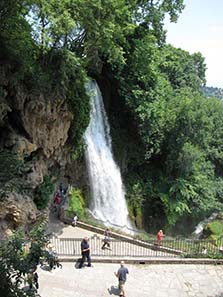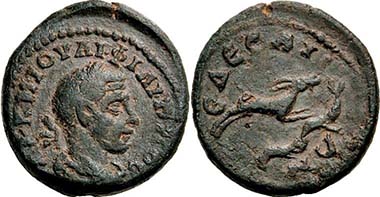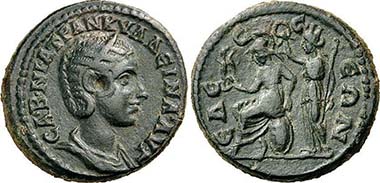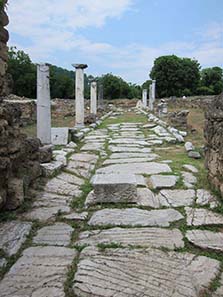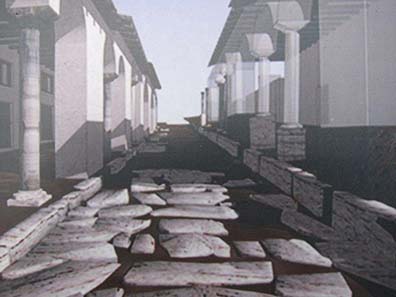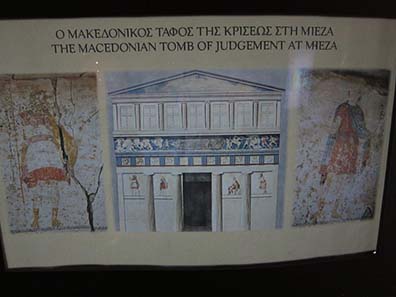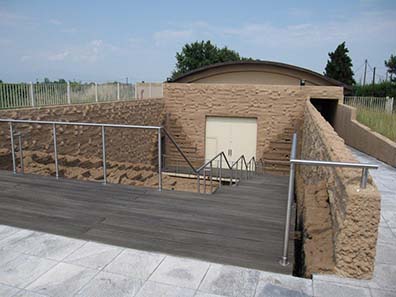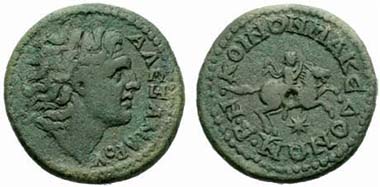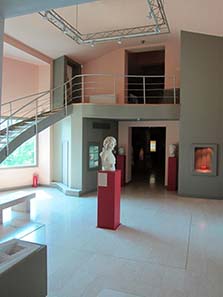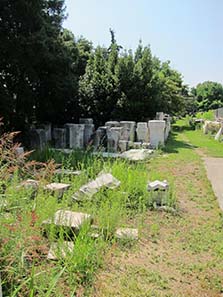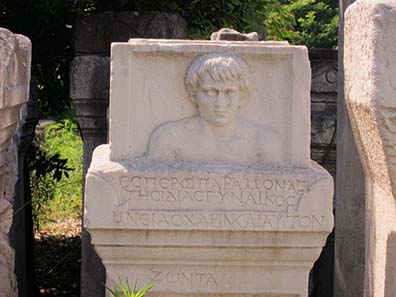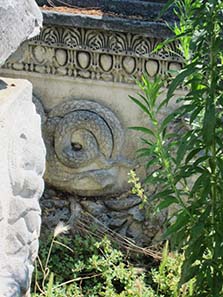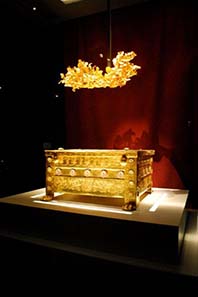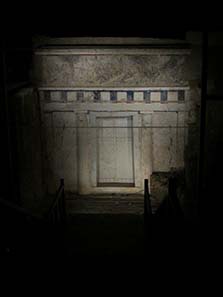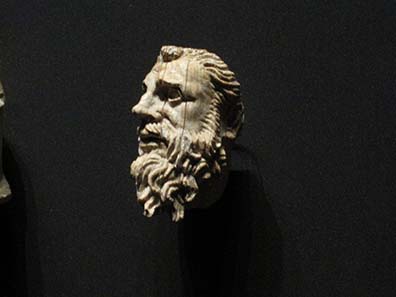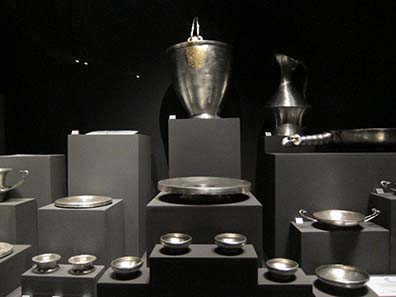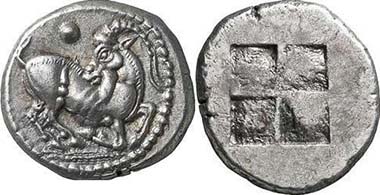by Ursula Kampmann
July 14, 2011 – On the fourth stage of her journey throughout Greece, Ursula Kampmann is looking for the ancient Aigai (one of so many…), an open museum and the magnificent tombs of Vergina…
Day 9, June 18, 2011, To the power center of the Macedon Kings
When leaving Ioannina it was perfectly clear: no matter where we were heading, our new destination had no chance to match up to Ioannina!
But one mistake we surely wouldn’t make again: spending so much time on looking for a hotel. Consequently, we picked the first hotel we came across in Veria, ancient Beroia. That, however, wasn’t a good choice. The first floor impressed with a spacious marble lobby but the rooms were small and definitely needed some redecoration. But, at least the air condition was working. Plus – and this is even more unbelievable – the hotel had WiFi so that I was able to send the first part of the diary on its way to Germany…
Of course, in the morning we only stayed as long in the hotel as it took for us to toss our luggage in the room. We immediately departed towards north because there were so many attractions to visit, like Macedon Edessa, ancient capital city of the Argeads.
Waterfall of Edessa, a famous destination of an excursion with Greeks. Photograph: KW.
According to Herodotus, the name of this Greek city stemmed from the Phrygian word for water (= vedy). It is said that in antiquity Edessa was referred to as Garden of Midas. Indeed, the population of this area needn’t worry about tourism since they earn their living with fruit cultivation. Countless cherry, apricot and peach trees supply the supermarkets of Northern Europe with fruits.
Anyone who associates “Edessa” rather with Urfa in Mesopotamia is likewise right. That city was founded by Seleucus I Nicator in remembrance of Macedon Edessa.
Edessa (Macedonia). Philippus I Arabs. Rev. goat, other unidentifiable animals below. From auction Peus 398 (2009), 642.
Whereas, for a long time, ancient Aigai was thought to be situated near Edessa, nowadays Vergina seems the more likely candidate but there is still some indication favoring Edessa, like a coin from the time of Philippus I Arabs. It shows a goat – the goat plays a vital role in the foundation myth of Aigai: the animal allegedly showed two members of the Macedon royal family at the beginning of the 7th century where to found the new capital city.
Be it Edessa or Aigai – anyway, the water-rich and fructiferous city remained to be important throughout history, which is somewhat of a nuisance to archaeologists. After all, it is very improbable that they will be able to unearth the alleged finds on the acropolis hill after all. Edessa is a vibrant city whose buildings cover the entire hill.
The most important attraction is the waterfall causing real attacks of excitement and huge photographic orgies with the Greeks. (To anyone living near the Rhine Falls it rather is a nice reminiscence of home.)
Edessa (Macedonia). Gordian III. Bronze. Av. Tranquillina. Rev. Roma l. sitting, city goddess of Edessa behind her, crowning her. From auction Numismatik Lanz 150 (2010), 375.
On the other hand, there is a nice little archaeological excavation at the foot of the hill which brought a gate with a part of a street to light. Finding the place was easy. Edessa is very interested in the expansion of tourism. Near the water falls we spotted – mirabile dictu – a tourist information where flyers in German language were available as well.
Upon entering the excavation site of ancient Edessa, a young woman followed us. First we thought that we had taken the wrong entrance and had to pay fee, but no, entrance was free but we ought to take the flyer to appreciate the excavation properly.
Remains of ancient Edessa: street of columns. Photograph: KW.
And she reminded us to watch out for snakes. To enforce her point, the lady wore a stick like the one many Greeks lug around on archaeological excavations. The stick serves the purpose to keep the aggressive reptiles at an arm’s length. Our experience, on the other hand, in the previous days had been that these poor animals were quite afraid of us and hence showed themselves only reluctantly. They hide once they feel the ground vibrating. So, it is much more effective to step firmly than to carry a stick. In addition, it might be clear as daylight not to sit on a sunny stone without checking first…
Reconstruction of the gate area of Edessa. Photograph: KW.
It was hot in Edessa. The excavation was nice, interesting, but not exactly setting the world on fire. Hence, we skipped the signposted archaeological round tour and headed for the famous tombs of Lefkadia.
Tomb of Judgement / Lefkadia. Photograph: KW.
Like he official travel guide of the “Hellenic Ministry of Culture and Tourism – Bank for Archaeological Means and Expropriation“ (sic!) says: “The remains of the ancient city of Mieza and its villages with their individual roads of tombs make up a complex of buildings that are as important for the history of ancient Macedonia as the monuments of Aigai in present-day Vergina.” In contrast to celebrated Vergina the almost more gorgeous tombs of Lefkadia are well-hidden and safely locked.
Locked Tomb of Judgement. Photograph: KW.
We visited all tombs we encountered: the Tomb of Lyson snd Kallikles, the Kinch Tomb, the Anthemion Tomb and the Tomb of Judgement. They were all locked. One wonders, why. When inclined to believe the photographs (and why not?) a least the architectonic remains of the Tomb of Judgement are without doubt more impressive than the so-called Tomb of Philipp II.
One possible reason might be the repercussions of the Greek economical crisis. Malicious gossip might as well spread the theory that, despite their significance, the Lefkadia tombs are hidden from the public to prevent any analogy being drawn between them and Vergina. When comparing these two one might discover that Vergina is not as outstanding as it is always thought to be. Yes, there are magnificent gold objects. Similar ones, however, can be viewed in the Archaeological Museum of Thessaloniki. Yes, the little ivory heads are very beautiful but similar parts of kline beds are exhibited in many museums in Northern Greece. Is the reason for the abundance of gold in the Vergina tombs not only simply due to the fact that they hadn’t been plundered? This goes without the need to drag Philipp II into this…
Be that as it may, we had enough for one day. After the frustrating search for the Macedon tombs we were in need for some good news! And we found them. In Beroia we discovered a tavern hardly any tourist visits. The menu was written in Greek only anyway. The waiter was amazed at me ordering my favorite dishes without hesitation – Tzaziki, aubergine salad, small balls of zucchetti, filled aubergines and a hot bean dish – without speaking any Greek. Well, I explained to him using both hands and feet: one has to set priorities, even when learning a language. And what could be more important than to order the things one likes?
Day 10, June 19, 2011, Vergina or The day of closed museums
We woke up early. The night had been uncomfortable. One possible option was to freeze to death with the air condition turned on; the other was death by suffocation due to the air condition being turned off. An interesting choice. The whole night through we contemplated both ways to die. Unfortunately, we arrived at different conclusions. Against all odds, we survived to see the morning and couldn’t wait to get outside.
Koinon of Macedonia. Bronze, Beroia(?). Av. Alexander r. Rev. Alexander riding a horse. From auction Rauch Sommerauktion 2009, 183.
Although there is no archaeological excavation in Beroia and the ancient remains are scattered throughout the cityscape, this polis belongs to the most ancient and most important ones in Macedonia. Neolithic idols had been found here indicating a settlement since New Stone Age. Thucydides was the first who mentioned Beroia in his account of the Peloponnese War. It was here where, in 432, the Athenian troops and Perdikkas II met. Under the reign of the Diadochi, the city flourished. The boom didn’t come to an end when the Romans seized Macedonia. Beroia was the first city that surrendered – and Rome rewarded that.
Koinon of Macedonia. Bronze, Beroia(?). Av. Alexander r. Rev. Juvenile sacrificing with a patera in front of a burning altar; to the left price table with two price wreaths, price amphora on high column behind. From auction Giessener Münzhandlung 126 (2003), 1763.
Nerva granted Beroia the neokoria and made the city a metropolis. Since then, the provincial government held sessions there; local politicians met there; the most important games were held there. Hence, the scientists think that the coinage of the Koinon of Macedonia was produced in Beroia.
In A. D. 50, Paul is said to have visited the city. The tribune he stood on when preaching was incorporated into a modern religious center (we skipped it). At the end of the 3rd century, the city smarted under the repercussions of the migration of the peoples, but under Byzantine rule it must have experienced a second bloom – the 51 churches which are said to have existed back then indicate that. The exact date of the Ottomans taking over Beroia can’t be ascertained with absolute certainty. In any case, they had to surrender the city again when in 1912 the whole of Macedonia fell to Greece again.
Entrance of the Beroia museum. Photograph: KW.
Beroia has a superb Archaeological Museum that – will wonders never cease! – was actually open even though we thought different at first, looking at the door closed. While we were still looking for a sign telling us the opening hours, a guard came running to open up for us and to collect 2 Euros entrance fee. Why should he have waited in the hot exhibition rooms? During our entire visit, which took roughly 1.5 hours, not a single tourist came to visit the museum.
Head of river god Olganos. Photograph: KW.
That was a pity since the Beroia museum has much to offer! And we are not only talking about the magnificent inscriptions and grave stelai, particularly from Roman times.
Tanagra figurines. Photograph: KW.
Especially remarkable were the high-quality Tanagra figurines from sepulchral finds. When looking at the objects being arranged in groups it becomes clear that they all come from the same mould even though they were reworked later on.
Some Bronze coins from sepulchral finds. Photograph: KW.
Some coins from sepulchral finds were exhibited as well, of course not identified and poorly illuminated but still!
View into the museum’s garden. Photograph: KW.
The view into the museum’s garden was a particular surprise. Unlike common practice in Greece, there were not just some stone remains of poor quality exhibited, but entire battalions of artistically outstanding objects. They stood in rank and file, so tight that only the ones in the first row could be marveled at.
Detail of a grave stele. Photograph: KW.
Like a grave stele, for example, possibly from the 3rd century A. D. (I am already waiting for an expert archaeologist to revise me). At the top a high-quality en face portrait, below a depiction of the entire family.
Detail of a sarcophagus. Photograph: KW.
At another time, we had to climb in order to get a good view at the work of art, like this sarcophagus with an enchanting depiction of a snake.
We were absolutely delighted at the Archaeological Museum and were already looking forward to seeing the Byzantine Museum, boastfully praised by our guide book as “state-of-the-art” and “an architectonic attraction”. It wasn’t easy to find. We only found the building with our third attempt. Then we were taken aback. The opening hours were clearly stated: Tue-Su 8:30 a.m. – 3 p.m. (just like almost all other museums). It was Sunday. It was 11 a.m. The door, however, was locked. And that after trying to find that stupid museum for almost an hour. Naturally, we didn’t give up that easily. I grabbed my mobile and keyed in the number stated at the entrance when Kurt – being much more pragmatic – simply rang the bell. A man actually got out the museum. But instead of letting us in, he informed us that the museum was closed. Yes, there had been signs, but, unfortunately, they had been stripped of. Due to cost cuts as a result of the economic crisis the museum had been closed for the public.
Well, yes, that’s understandable. Admittedly, Beroia is not really crawled with tourists. But: they surely won’t grow in number when all attractions in the vicinity are closed.
Entrance to the museum of the Vergina finds. Photograph: KW.
The modern museum of Vergina, in contrast, has very different opening hours: Tue-Su 8 a.m – 7 p.m. That time span is surely justified in the light of those huge groups, mainly of Greek tourists, being carted to the museum every ten minutes to marvel at the so-called Tomb of Phillip II. Thank god, the Ephorate of Prehistoric and Classical Antiquities collects an adequate entrance fee: 8 Euros. Let’s hope that the yields Vergina generates are used for making other excavation sites accessible as well.
Larynx and gold wreath, allegedly belonging to Phillip II. Photograph: Sarah Murray / Wikipedia.
I confess, Vergina keeps making me angry. This is perhaps due to the fact that I visited Athens in 1991, shortly after the Republic of Macedonia had been founded. Back then, entire Greece was in turmoil at the chuzpah of that Balkan state daring to occupy the sacred name of the Empire of Macedonia for his state! Even worse: the national flag showed the star of Vergina! It wasn’t all about vanity; Greece truly feared for the integrity of his territory. After all, Macedonia had only come to Greece as late as 1913; even after World War II there was still the issue which country Macedonia ought to belong to.
Anyhow, Athens immediately shut the border crossings to Macedonia and prohibited the use of the Thessaloniki port where the state had transacted 80% of his imports.
Anyone visiting Greece with eyes open back then could see how history and archaeological finds were invoked to defend Greece’s claim on the name “Macedonia”. Even on the phonecards I used to buy (those were the days when phonecards were used to make a phone call from a callbox…) it was said: Macedonia remains Greek! The Macedonian heritage was emphasized everywhere, and the Dora Stratou Theater in Athens devoted its entire program to Macedonian attire and folk dance. By the way, the archaeological excavations in Vergina were concluded in 1992…
Although the boycott of Macedonia was seized in 1994 and the situation became normal again since then, the nationalistic background has to be born in mind when visiting the Vergina museum, which was opened in 1997. This is the main reason why there is really no discussion at all if the finds are rightfully attributed to Philipp II.
So-called Tomb of Philipp II.
What are the pros? First of all, the rich finds which are really impressive. Another argument was put forward by a Greek pathologist who concluded from a part of the skull still preserved after the cremation that the eye socket of the deceased was being hit – according to ancient writers, Philipp had suffered a similar injury. Unfortunately, the pathologist’s colleagues have voiced their sincere doubts about that hypothesis. Last but not least, let’s have a look at the two famous grieves, one being a bit shorter than the other. Philipp is said to have had a shortened foot due to another battlefield injury, which would suit the argument very well. That grieves, however, were not the only ones “Philipp” received for his grave. As far as I know, the other ones were of equal length.
Be that as it may, I love the idea that these finds are the grave inventory of Philipp. Scientifically, however, it is far from being proven. It classifies as falsification of history when there is no recognition of the interpretation of the finds being controversial. To me, that is scientific dishonesty!
Dionysos group from the Tomb of the Prince. Part of a kline bed.
Apart from that, the quality of the exhibited finds is extraordinary. It would be an aesthetic delight to view them all if the museum didn’t take itself so serious. The visitor comes into a dimmed room where all light is directed towards the floor. Best thing is to firmly take your companion by the hand to prevent getting lost in the dark when tripping on stairs.
An old man’s head. Part of a kline bed.
The ivory carvings are especially fantastic. The head of an old man is my favorite. By the way, such ivory carvings are not restricted to Vergina, but can be viewed in many museums in Macedonia. The kline bed decorated with ivory carvings seems to have been standard equipment of the grave inventory of important Macedonians.
Silver tableware from the Tomb of the Prince.
It is the same with the silver table ware. Here you can see a gorgeous example from the “Tomb of the Prince”. After all, not only the tomb of “Philipp” has been found but three other chamber graves as well (which, architectonically, don’t rank behind the ones in Lefkadia). Yet the finds are presented in a way that they appear to be connected with the “Tomb of Philipp”.
Aigai or Macedonian tribe of Mygdones or Krestones. He-goat r. Rev. Quadratum incusum. From Giessener Münzhandlung 146 (2006), 155.
But enough of complaints. Let’s rather turn out attention to the splendid coins of Aigai, one-of their-kind. The majestic he-goat on them! It is of no relevance that these magnificent pieces in all probability weren’t produced in Aigai. Two things contradict that theory: on the one hand, it is very unlikely that a civic coinage was made in the royal capital; on the other hand, Aix, from which Aigai stems, means goat. And the staters show quite a he-goat!
Almost as tricky as the coins is – as already stated in the context of Edessa – the question if Vergina is identical with Macedonian Aigai at all. Distinguished expert on Macedonian history and archaeology, N. Hammond, was the first to put the suggestion forward in 1968 – he is enthusiastically approved and supported with good reasons.
The archaeological excavation of Vergina: closed. Photograph: KW.
I would have liked to show you the architectonic remains of the former palace. Unfortunately, that isn’t possible. Without giving any reasons, the entire archaeological excavation of Vergina is closed until December 31, 2011, at least.
Don’t miss accompanying us to Dion in the next issue, where Alexander once sacrificed before he departed to his campaign against the Persians. We’ll visit Mount Olympus and Thessaly…
Anyone who would like to see the treasures of Northern Greece with his own eyes might be interested in a tour I will be guiding in autumn, on behalf of Klingenstein. For more information please click here (available in German only).
You can read all other parts of this diary here.





